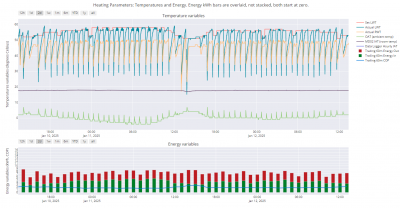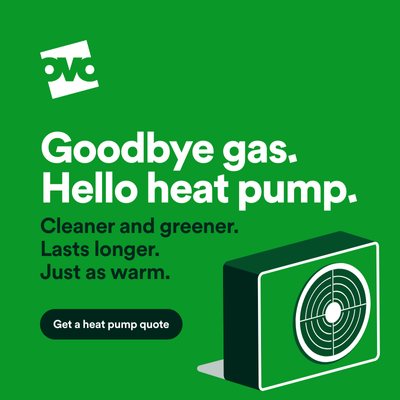Can you work an ASHP too hard?
Thank you. I definitely plan a full flush. The pipework is 40 years old, but we have been here since 1988 and never had problems eg with balancing or slow temperature pickup, which gives me some comfort.
I am posting this here (it also on another thread), because I think it is relevant to this thread's title. Last Wednesday I upped the WCC left hand as far as I dare go, baseline LWT of 57 degrees at -2 degrees OAT, with the potential to reach 60 degrees, the upper operating limit for my heat pump, if my auto-adapt script kicks in. This means that given the low OATs over the last 48 hours, my heat pump has been running flat out most of the time.
I am running it like this to try to fix the heat deficit at low OATs (IAT fell too low). They key thing is I noticed that in these conditions, when defrosts dominate the picture, the actual LWT rarely (but not never) exceeds the set LWT, unlike 'normal' cycling, when it does (it under-shoots and over-shoots, achieving a mean actual LWT close to the set LWT). This gave me just enough confidence to boost the set LWT to very close to max, in the expectation it wouldn't exceed the operating limit, and at least so far it hasn't.
Is this a bad way to run my heat pump? I don't know. On one level it shouldn't be, because although it is running hard, it is nonetheless within its operating limits, and if it has an operating range, then it should jolly well run just fine in that operating range. But I think we also have a sort of collective folk memory that running things hard does things in. But that isn't always the case. Small marine diesels (the sort found in yachts and launches etc) are meant be run hard, close to their upper operating limit, without suffering at all. In fact you can even do more harm by running them less hard. One manufacturer (Yanmar) even says if you don't run the engine hard, you should at least race every few hours. Perhaps our heat pumps are the same? They are OK running hard.
I wonder how much if any real world data there is on heat pump failures caused by being run hard, but still withing their operating ranges?
Midea 14kW (for now...) ASHP heating both building and DHW
Interesting, thank you. The marine diesel analogy was on my mind. At the other end is a F1 engine needing to be rebuilt after every race. You would think that a HP would be built to run steadily at high outputs- at the marine diesel end of the spectrum.
In a commercial context with multiple heat pumps in tandem, how are individual HPs brought online when heating/ cooling load is low to mid range?
Posted by: @simonwhiteleyThe marine diesel analogy was on my mind. At the other end is a F1 engine needing to be rebuilt after every race. You would think that a HP would be built to run steadily at high outputs- at the marine diesel end of the spectrum.
I agree - I think a heat pump is more of a marine diesel than a F1 engine. It is meant to run day in day out, not have a short spell in the limelight racing round Brands Hatch and then blow up!
I think the key point has to be the manufacturers' operating ranges. As long as they don't have duty cycles that say for example the heat pump can only be run at 8-100% of max output for one in every six hours (which some marine diesels do, the so called max and continuous ratings), then the operating range is the operating range. As long as you are in range, it should be OK. If you need to limit the range, then the manufacturer needs to explicitly say that.
Midea 14kW (for now...) ASHP heating both building and DHW
@simonwhiteley Have you come across this in your travels? It seems relevant to your situation.
https://protonsforbreakfast.wordpress.com/2024/10/08/deliberately-under-sized-heat-pumps/
Mitsubishi EcoDan 8.5 kW ASHP - radiators on a single loop
210l Mitsubishi solar tank
Solar thermal
3.94kW of PV
Thank you. PfB is one of my go-to guys but I hadn’t seen that. My situation is quite similar to the one described: visual intrusion and noise limits are both constraints on HP size as is installing emitter capacity suitable for achieving HP efficiency (I started a separate topic on that in the Radiator section of the forum).
Broadly I think I can get noise limits and emitter capacity to line up with my preferred heat pump. The question is how many days a year will I need heat from the backup?
Uncertainty over my heat loss estimates is a complication (also similar to the PfB piece). In a winter like this one, and using my midrange heat loss estimates, the backup should be needed for perhaps two weeks. In a more normal winter, just a few days. If the high end heat loss estimates are right, in a cold winter 😱.
I do have a contingency plan (a small air to air system) but it would be a challenge to get planning permission with existing technology (most air to air HPs are c5dB noisier than the same sized air to water HPs) and the usual planning permission approach to adding up noises from different sources is quite restrictive.
But it does feel like a big exercise in planning under uncertainty- I enjoy the challenge, have the time to wrestle with it, and can tolerate a fair amount of risk. The me of 30 years ago would not have felt that way.
@harriup Thanks for posting this link. I was trying to find the article again a few days ago. Using the 'standard' heat loss methods, a 12kW Vaillant unit has been proposed for my property. I suspect a smaller 8-9kW unit with backup heater would suffice. I have derived my own heating power/days per year graph and determined that in the 2023-24 heating season there were only 4-5 days in the 80-100% band.
As someone with an over-sized HP and the lower level of performance this entails for much of the year this strategy has a lot of appeal! I have a good record of temperatures for the past couple of years, and there are only a few days where the daily average is below 0° (this is in a rural town, not a big city either). On those days the temperature will fluctuate and go above 0° as well - I think I have only spotted one continuous stretch when it stayed below freezing for over 24 hours. So even if a heat pump is under-sized and the house loses heat faster than it is put back in for a short period, heat energy stored in the fabric means the internal air temperature won't plummet and become uncomfortable too quickly and the house can regain heat as the temp rises. Of course though, every house has different themal properties.
The achilles heel in this thinking is that below 0° I see HW and defrost cycles taking up around 30% of the operating time, so even for a HP that is over-sized compared to actual heat loss, if this was sustained for several days (hello Scotland!) then the house would require an additional heat input.
Mitsubishi EcoDan 8.5 kW ASHP - radiators on a single loop
210l Mitsubishi solar tank
Solar thermal
3.94kW of PV
- 26 Forums
- 2,342 Topics
- 53 K Posts
- 209 Online
- 6,000 Members
Join Us!
Worth Watching
Latest Posts
-
RE: Poll for Time of Use, tariffs, technology
How is a human supposed to understand the integrations ...
By Batpred , 3 hours ago
-
RE: Commencing on an ASHP Installation Process
I've got a bit of time to draft something today, so the...
By Sheriff Fatman , 5 hours ago
-
RE: Setback savings - fact or fiction?
The predicted values are based on assumptions and it is...
By RobS , 5 hours ago
-
RE: Help with heat pump sizing
@amin I dont think materially relative to t...
By JamesPa , 7 hours ago
-

Totally agree. The problem lies with what I was once ...
By Majordennisbloodnok , 7 hours ago
-

@majordennisbloodnok I have decided to take the plunge....
By TechnoGeek , 8 hours ago
-

RE: LiFePO4 lithium battery fires and explosions
I too had spotted the Na-ion battery and matching inver...
By Transparent , 9 hours ago
-
RE: Are We Sleepwalking Into Another Race to the Bottom?
Let' start with first thing first, HG is a startup, the...
By ksim , 13 hours ago
-
RE: Configuring third party dongle for Ecodan local control
@sheriff-fatman might be interested in this, f...
By F1p , 13 hours ago
-
RE: Different dT on each radiator?
I cant sorry. Its based on some calculations I did fro...
By JamesPa , 1 day ago
-
RE: Help me keep the faith with my air source heat pump installation
@simonf thats interesting as I’ve noticed my flow and r...
By AdamK , 1 day ago
-

RE: MELcloud scheduling misbehaviour
No, it gets to set temperature easily even during perio...
By Abernyte , 1 day ago
-
RE: Free Ecoheat Heat Pump Install
Sorry hit 'add reply' too early, this forum layout will...
By Deltona , 2 days ago
-
And arguably even more important, sodium will be hopefu...
By Batpred , 2 days ago
-
RE: A Smarter Smart Controller from Homely?
I've been thinking of emailing Homely to ask for a few ...
By JohnnyB , 2 days ago
-
Max output of Heat pump (Daikin 4Kw EDLA04)
Hello, I am a bit puzzled that according to pcdb tes...
By GeorgeA , 2 days ago
-

RE: Has Anyone Else Noticed a Decline in Tradesmanship?
@cathoderay Hence my rider about ‘all else being equal’...
By Toodles , 2 days ago
-

RE: Heat Pump Performance Analysis Web App using Modbus Data
@redzer_irl — all my heat pump data is in csv files, me...
By cathodeRay , 2 days ago





